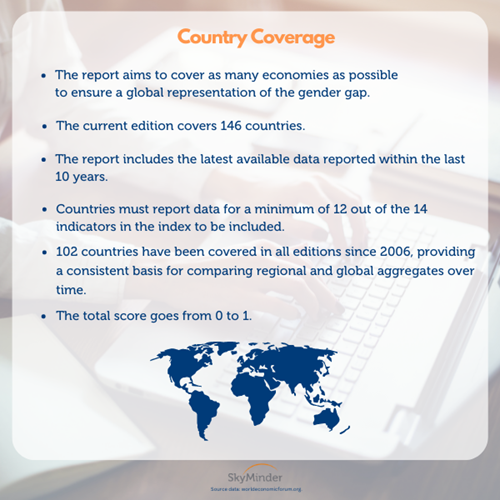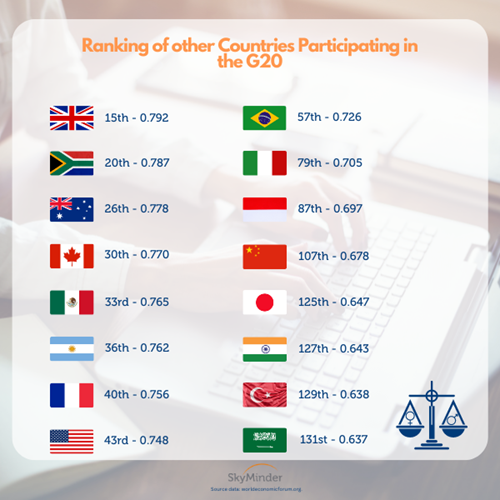Analysis and Studies - Studies
Global Gender Gap Report 2023: an insight
June 23rd 2023
The World Economic Forum (WEF) is an international organization committed to improving the state of the world by engaging leaders from various sectors to shape global, regional, and industry agendas. Founded in 1971, the WEF is headquartered in Geneva, Switzerland. It brings together government officials, business leaders, academics, and representatives from civil society to address pressing global issues and find collaborative solutions. Overall, the World Economic Forum plays a crucial role in shaping the global agenda, fostering dialogue, and promoting collaboration among leaders from various sectors to address global challenges and drive positive change.
 The Global Gender Gap Index (GGGI) is an annual report published by the World Economic Forum (WEF) that measures and tracks gender-based disparities across countries and regions. Introduced in 2006, the GGGI aims to provide a comprehensive assessment of gender equality and identify areas where progress is needed.
The Global Gender Gap Index (GGGI) is an annual report published by the World Economic Forum (WEF) that measures and tracks gender-based disparities across countries and regions. Introduced in 2006, the GGGI aims to provide a comprehensive assessment of gender equality and identify areas where progress is needed.
Key points about the Global Gender Gap Index include:
- Dimensions of Measurement: The GGGI evaluates gender gaps across four key dimensions: economic participation and opportunity, educational attainment, health and survival, and political empowerment. These dimensions offer a holistic view of gender disparities and enable comparisons between countries.
- Methodology: The GGGI employs a data-driven approach to measure gender gaps. It utilizes a set of indicators within each dimension to analyze gender disparities. The indicators are selected based on their relevance, availability, and comparability across countries.
- Data Sources: The GGGI utilizes a variety of data sources, including national statistics, international organizations, and surveys. The data used for the index is obtained from credible and reliable sources, ensuring the accuracy and validity of the findings.
- Index Ranking: The GGGI ranks countries based on their performance in closing the gender gap. Countries are assigned scores on a scale of 0 to 1, with 1 indicating complete gender equality. The rankings provide a comparative assessment of progress and allow for benchmarking between countries.
- Impact and Awareness: The GGGI has had a significant impact in raising awareness about gender equality issues globally. It has helped policymakers, organizations, and advocates understand the magnitude of gender disparities and the importance of closing the gap for social and economic development.
- Policy Implications: The GGGI findings offer valuable insights for policymakers to prioritize gender equality initiatives. The report highlights areas where countries excel or lag behind, providing guidance for targeted policy interventions and reforms.
The Global Gender Gap Index serves as a vital tool for tracking progress towards gender equality, identifying challenges, and promoting dialogue and action to address gender disparities worldwide. It has become a reference point for understanding the status of gender equality and shaping policies and practices towards a more inclusive and equitable society.
 Among the top-ranking countries on the gender parity scale, European nations such as Iceland, Norway, and Finland emerge as leaders with impressive scores of 0.912, 0.879, and 0.863, respectively. Notably, other European countries like Sweden, Germany, Belgium, and Lithuania also feature prominently in the rankings. New Zealand secures the fourth spot, demonstrating its commitment to gender equality.
Among the top-ranking countries on the gender parity scale, European nations such as Iceland, Norway, and Finland emerge as leaders with impressive scores of 0.912, 0.879, and 0.863, respectively. Notably, other European countries like Sweden, Germany, Belgium, and Lithuania also feature prominently in the rankings. New Zealand secures the fourth spot, demonstrating its commitment to gender equality.
Interestingly, the list of top ten countries includes some unexpected names, such as Namibia and Nicaragua. These nations have made commendable strides in achieving gender parity, showcasing their dedication to fostering equal opportunities and rights for all.
These results highlight the positive progress made by European countries and showcase the efforts of nations like Namibia and Nicaragua in breaking barriers and creating more inclusive societies. The global pursuit of gender parity continues to evolve, with these countries serving as inspiring examples for others to follow.
 Among the G20 countries, the United States finds itself at the 43rd position in the gender parity rankings. Following closely is Italy, ranked at 79th place, indicating room for improvement in terms of gender equality. Japan ranks even lower, occupying the 125th spot, emphasizing the need for greater efforts to bridge the gender gap. Saudi Arabia, another G20 member, ranks at 131 out of 146 countries, indicating significant challenges in achieving gender parity within the nation.
Among the G20 countries, the United States finds itself at the 43rd position in the gender parity rankings. Following closely is Italy, ranked at 79th place, indicating room for improvement in terms of gender equality. Japan ranks even lower, occupying the 125th spot, emphasizing the need for greater efforts to bridge the gender gap. Saudi Arabia, another G20 member, ranks at 131 out of 146 countries, indicating significant challenges in achieving gender parity within the nation.
These rankings shed light on the varying progress made by G20 countries in promoting gender equality. While some nations have made notable advancements, others still face considerable obstacles. It underscores the importance of continuous commitment and comprehensive policies to address gender disparities and foster inclusive societies on a global scale.
Regional Findings
The Global Gender Gap Index provides insights into the gender parity status across different regions. Here's a summary of the key findings:
Europe takes the lead in gender parity, surpassing North America, with a score of 76.3%. Countries like Iceland, Norway, and Finland perform well in this region. North America follows closely behind with a parity score of 75%, although there have been slight declines in overall parity for Canada and the United States.
Latin America and the Caribbean have made progress, bridging 74.3% of their gender gap. Nicaragua, Costa Rica, and Jamaica are among the countries with higher parity scores in this region.
Eurasia and Central Asia rank fourth with a parity score of 69%. Moldova, Belarus, and Armenia are the top-performing countries, while Azerbaijan, Tajikistan, and Turkey have lower scores.
East Asia and the Pacific score 68.8%, marking the fifth-highest parity score among the regions. New Zealand, the Philippines, and Australia exhibit better gender parity, while Fiji, Myanmar, and Japan face challenges.
Sub-Saharan Africa ranks sixth with a parity score of 68.2%. Namibia, Rwanda, and South Africa have made notable progress, while the Democratic Republic of the Congo, Mali, and Chad lag behind.
In Southern Asia, gender parity stands at 63.4%, making it the second-lowest score among the regions. The region has seen a modest increase of 1.1 percentage points since the last edition, with countries like India, Pakistan, and Bangladesh contributing to this improvement. Bangladesh, Bhutan, and Sri Lanka perform better in terms of gender parity, while Pakistan, Iran, and Afghanistan lag behind. At the current rate of progress, it will take approximately 149 years to achieve full gender parity in the region.
The Middle East and North Africa region faces the greatest challenges in achieving gender parity, with a score of 62.6%. There has been a decline of 0.9 percentage points in parity since the last edition. The United Arab Emirates, Israel, and Bahrain have made relatively better progress, while Morocco, Oman, and Algeria rank lower. Even the region's most populous countries, such as Egypt, Algeria, and Morocco, have experienced declines in their parity scores. At the current pace, it will take about 152 years to achieve full gender parity in the Middle East and North Africa region.
